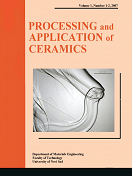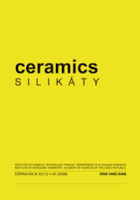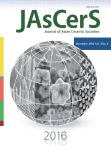
JOURNAL OF THE CERAMIC SOCIETY OF JAPAN
Scope & Guideline
Transforming ideas into advanced ceramic solutions.
Introduction
Aims and Scopes
- Ceramic Synthesis and Processing:
Research on various synthesis methods including sol-gel, hydrothermal, and traditional solid-state techniques to develop new ceramic materials with desirable properties. - Material Characterization:
Detailed analysis of the microstructural, thermal, mechanical, and electrical properties of ceramics using advanced characterization techniques such as X-ray diffraction, scanning electron microscopy, and spectroscopy. - Functional Ceramics:
Exploration of ceramics with specific functional properties, including piezoelectric, ferroelectric, and dielectric materials, aimed at applications in electronics, sensors, and energy devices. - Biomedical Applications:
Investigation of bioceramics and their interactions with biological systems, focusing on their use in tissue engineering, drug delivery, and as bioactive materials. - Environmental and Energy Solutions:
Research aimed at developing ceramic materials that contribute to sustainability, such as catalysts for environmental remediation and solid electrolytes for batteries. - Nanostructured and Composite Ceramics:
Study of advanced ceramic composites and nanostructured materials to enhance performance characteristics and broaden application scopes.
Trending and Emerging
- 3D Printing and Additive Manufacturing:
A surge in research related to the additive manufacturing of ceramics, emphasizing innovative techniques and the development of new materials suitable for 3D printing. - Nano-enhanced Ceramics:
Increasing studies on nanostructured ceramics that leverage nanoscale materials to achieve superior properties and functionalities. - Environmental Sustainability:
Growing emphasis on the development of eco-friendly ceramics, including waste recycling and bio-based materials, to address environmental challenges. - Smart and Multifunctional Ceramics:
Research focusing on ceramics with integrated functionalities, such as self-sensing, self-healing, and energy harvesting capabilities. - Computational Materials Science:
An emerging trend in utilizing computational methods for the design and optimization of novel ceramic materials, paving the way for accelerated discovery and innovation. - Energy Storage and Conversion Technologies:
Increased focus on ceramics for energy applications, particularly in the development of solid-state batteries and fuel cells, as the demand for efficient energy solutions grows.
Declining or Waning
- Traditional Ceramic Applications:
Research related to conventional applications of ceramics, such as traditional pottery and porcelain, has seen a decrease as the focus shifts towards advanced materials and technologies. - Single-phase Ceramic Materials:
There is a declining interest in studies limited to single-phase ceramic materials, with more emphasis being placed on composite materials that exhibit enhanced properties. - Low-temperature Sintering Techniques:
While initially a hot topic, the focus on low-temperature sintering has diminished as researchers explore more efficient and innovative processing methods that enhance material performance. - Static Mechanical Properties:
Research concentrating solely on static mechanical properties of ceramics is less prominent, as there is a growing interest in dynamic and functional performance under operational conditions. - Glass Ceramics:
The focus on traditional glass ceramics has waned as newer materials and hybrid systems gain attention for their multifunctional capabilities.
Similar Journals

JOURNAL OF ELECTROCERAMICS
Unveiling Cutting-edge Discoveries in Materials ScienceJOURNAL OF ELECTROCERAMICS, published by SPRINGER in the Netherlands, serves as a pivotal platform for advancing the field of electroceramics since its inception in 1997. With a keen focus on innovative materials and applications, this journal covers diverse areas encompassing ceramics and composites, condensed matter physics, and electronic materials, significantly contributing to interdisciplinary research. Although currently not an Open Access publication, the journal's engagement in rigorous peer review ensures the dissemination of high-quality research, supported by its respectable Q3 ranking in several relevant categories in 2023. Researchers and professionals will find value in its comprehensive scope, showcasing cutting-edge developments that shape the future of engineering and materials science. The JOURNAL OF ELECTROCERAMICS continues to play a crucial role in bridging theoretical discoveries with practical applications, making it an indispensable resource for students, scholars, and industry experts alike.

Processing and Application of Ceramics
Exploring Innovations in Ceramic ProcessingProcessing and Application of Ceramics is a prominent open-access journal dedicated to the advancement of knowledge in the field of ceramics and composites. Published by the University of Novi Sad, Faculty of Technology in Serbia, this journal has been fostering research and innovation since its inception in 2007. With its ISSN 1820-6131 and E-ISSN 2406-1034, this journal is indexed in Scopus, where it holds a ranking of #82 out of 127 in the Materials Science category, placing it in the 35th percentile and within the Q3 quartile as of 2023. Spanning a convergence period from 2014 to 2024, the journal serves as a vital platform for researchers, professionals, and students alike, eager to explore the latest developments in ceramic materials, their processing techniques, and practical applications. The journal's commitment to accessibility and quality makes it an essential resource for those aiming to stay at the forefront of ceramics research.

CERAMICS-SILIKATY
Transforming Ideas into Impactful Ceramic SolutionsCERAMICS-SILIKATY is a distinguished open-access journal published by the University of Chemistry and Technology, Prague, specializing in the fields of Ceramics and Composites, Analytical Chemistry, Chemical Engineering, and Materials Chemistry. Since its inception in 1991, this journal has played a pivotal role in disseminating cutting-edge research and innovative findings in the study of ceramics, emphasizing both fundamental and applied aspects. With a commitment to accessibility since 2000, CERAMICS-SILIKATY promotes knowledge sharing among researchers, professionals, and students globally. The journal's current standing in the Q3 Quartile across several categories highlights its significant contributions and relevance in the academic community. As a hub for interdisciplinary research, the journal invites submissions that advanced our understanding of ceramic materials and their applications, positioning itself as an essential resource for those engaged in the forefront of materials science.

Transactions of the Indian Ceramic Society
Exploring Innovations in Ceramic MaterialsTransactions of the Indian Ceramic Society is a distinguished journal published by Taylor & Francis Ltd, focusing on the vital field of ceramics and composites. With an ISSN of 0371-750X and an E-ISSN of 2165-5456, this journal serves as a crucial platform for disseminating cutting-edge research and innovations in ceramic materials science. Operating since 1941, it has established a solid reputation within the academic community, currently holding a Q3 ranking in the Ceramics and Composites category according to the 2023 Scopus rankings. Though not an open-access journal, it provides a wealth of insights and findings that can significantly impact both theoretical and practical applications in materials science. The journal aims to facilitate knowledge exchange among researchers, professionals, and students, thereby pushing the boundaries of what is possible in the world of ceramics. It is a valuable resource for anyone looking to advance their understanding and contribute to this ever-evolving field.

JOURNAL OF SOL-GEL SCIENCE AND TECHNOLOGY
Bridging Theory and Application in Sol-Gel ScienceJOURNAL OF SOL-GEL SCIENCE AND TECHNOLOGY, published by Springer, is a vital resource within the interdisciplinary fields of materials science and engineering, focusing on innovative research related to sol-gel processes and applications. With a rich publication history spanning from 1993, this journal enables the dissemination of cutting-edge findings in biomaterials, ceramics, and composites, ranking impressively across various categories—Q3 in Biomaterials and Q2 in several other materials-related fields. The journal's commitment to quality research is reflected in its Scopus rankings, particularly notable in the categories of Condensed Matter Physics and Materials Chemistry. Researchers and professionals leveraging the insights from this journal are supported through its comprehensive scope, which bridges theoretical foundations with practical applications, advancing knowledge and fostering collaboration among academics and industry leaders alike. As a non-open access journal, it is essential for subscribers and institutions to engage deeply with the latest advancements documented within its pages, underscoring the journal's role in shaping the future of sol-gel science and technology.

Journal of the Australian Ceramic Society
Unveiling the Potential of Ceramic InnovationsThe Journal of the Australian Ceramic Society, with ISSN 2510-1560 and E-ISSN 2510-1579, is a distinguished publication by SPRINGER, dedicated to advancing the field of ceramics and composites. Located in Switzerland, this journal serves as a vital platform for researchers, professionals, and students in the realm of materials science, particularly focusing on the innovative applications and developments within ceramics and materials chemistry. Achieving a Q3 quartile ranking in both the Ceramics and Composites and Materials Chemistry categories in 2023, it reflects its commitment to fostering knowledge exchange and intellectual discourse in these critical areas, as evidenced by its Scopus rankings. Spanning from 2007 to 2024, the journal not only supports rigorous peer-reviewed research but also encourages accessibility to cutting-edge findings, making it an essential resource for anyone engaged in ceramic materials research.

Journal of Advanced Dielectrics
Connecting Scholars Through Cutting-Edge Dielectric StudiesThe Journal of Advanced Dielectrics, published by World Scientific Publishing Co Pte Ltd, is a pivotal open-access platform since 2014 dedicated to advancing research in the fields of dielectrics, ceramics, and composites. Based in Singapore, this journal aims to bridge the gap between theoretical developments and practical applications in Electrical and Electronic Engineering, Condensed Matter Physics, and Electronic, Optical, and Magnetic Materials. With an impressive classification in the 2023 Quartile Rankings indicating its significance within its categories, and notable Scopus Rankings that highlight its impact and relevance, this journal serves as a vital resource for scholars and professionals committed to cutting-edge research and innovation. As it continues to flourish through the converging years from 2015 to 2024, the Journal of Advanced Dielectrics stands as an essential conduit for the dissemination of knowledge in advanced material sciences, making it an indispensable asset for today's research community.

Journal of Asian Ceramic Societies
Fostering collaboration in ceramic advancements.The Journal of Asian Ceramic Societies, published by Taylor & Francis Ltd, is a peer-reviewed open-access journal that has been at the forefront of ceramic research since its inception in 2013. With an ISSN of 2187-0764, this esteemed journal is dedicated to advancing the scientific understanding of ceramics and composites, bolstered by an impressive ranking of Q2 in the field of Materials Science. Covering a wide range of topics pertinent to ceramics, the journal aims to foster collaboration among researchers, professionals, and students across Asia and beyond. Its commitment to accessibility allows a global audience to engage with cutting-edge research, reflected in its Scopus ranking of #45 out of 127 in the Materials Science category. With a publication timeline extending to 2024, the Journal of Asian Ceramic Societies is an indispensable resource for anyone looking to stay informed on the latest developments and innovations in ceramic technology.

Open Ceramics
Innovating Beyond Boundaries in Materials ScienceOpen Ceramics is a pioneering journal published by Elsevier, dedicated to the field of materials science, with a particular focus on ceramics and composites. Launched in 2020, this Open Access journal aims to facilitate unrestricted dissemination of cutting-edge research findings while promoting innovative developments in the utilization of ceramic materials across various applications. As of 2023, Open Ceramics has established a commendable presence in several key categories, achieving Q3 in Biomaterials and Q2 rankings in Ceramics and Composites, Electronic, Optical and Magnetic Materials, and Materials Chemistry. The journal's broad scope appeals to a diverse audience of researchers, professionals, and students interested in the advancements within this essential domain of materials science. With a commitment to quality and relevance, Open Ceramics provides a platform for rigorous peer-reviewed research, thereby enhancing the global dialogue in the field and contributing to the ongoing progress of materials innovation.

Journal of Ceramic Science and Technology
Bridging Gaps in Ceramic Science and ApplicationJournal of Ceramic Science and Technology, published by GOLLER VERLAG GMBH in Germany, serves as a vital platform for advancements in the field of ceramics and composites. Since its inception in 2010, the journal has contributed significantly to the scholarly literature, encompassing a wide range of topics including the development of new ceramic materials, nanocomposites, and their various applications in industries such as electronics, energy, and medicine. Although currently categorized in the Q4 quartile of ceramics and composites and ranked within the lower percentile in Scopus, the journal strives to bridge the gap between fundamental research and practical implementation, fostering innovative solutions to contemporary materials challenges. With an open-access format, it ensures that valuable findings are disseminated widely, promoting collaboration and knowledge sharing among researchers, professionals, and students in the field. As it converges towards 2024, the Journal of Ceramic Science and Technology remains committed to enhancing the understanding and utilization of ceramic materials, making it an indispensable resource for those dedicated to advancing this dynamic area of study.